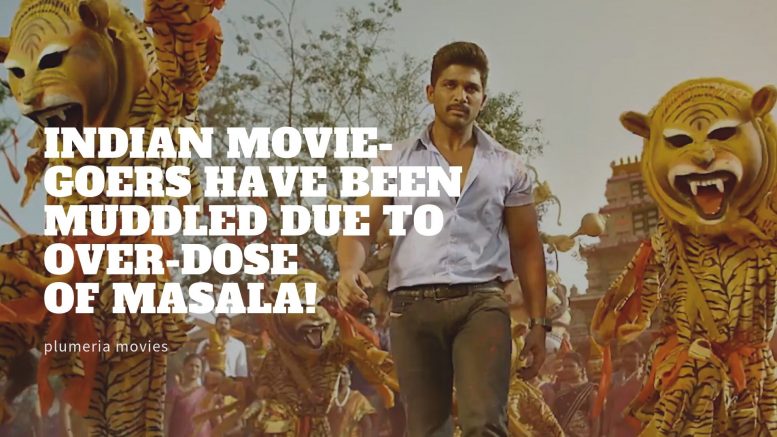The minds of average Indian movie-goers have, to a significant extent, been influenced by the prevalent overdose of masala films. Action Masala films in Indian cinema typically blend action, comedy, romance, and drama or melodrama, often featuring musical elements. This genre has become the most popular in Indian cinema.
Distorted Perception and Alarming Trends
The shrewdness of an average film buff in India appears to be distorted due to the repetitive nature of masala films. These movies often include an average of five songs, multiple over-the-top stunt scenes, and intricate love triangles, all woven into logic-less plots with shirtless heroes.
Indian Censor Board’s Role
Despite their content, the Indian Censor Board readily grants these films a U or U/A rating, making them accessible to audiences, including children under the age of twelve. This raises concerns about the impact of violent or inappropriate scenes on young minds.
Predictability and Lack of Creativity
Masala films follow a predictable pattern, with scenes stacked against each other in an incoherent manner. The inclusion of unnecessary scenes, often under the guise of comedy tracks, contributes to the overall lack of creativity. Viewers are subjected to inane, predictable stories that compromise creativity for the sake of entertainment.
Need for Uniqueness in Films
While adhering to the age-old format of love-dance routines, stunts, and familial melodrama, a movie should possess a unique factor that sets it apart from the clutter. The question arises: How will audiences accustomed to typical masala fare accept offbeat films that deviate from the established formula?
Conclusion: Striking a Balance
As Indian cinema navigates through the dominance of masala films, striking a balance between entertainment and originality becomes crucial. While masala films have their space, encouraging diverse storytelling and creativity should be promoted to cater to a more discerning audience.
Introduction: A Divergence in Tastes
The prevailing notion that the majority of Indian movie-goers perceive films merely as ‘feel-good entertainment pieces’ has led to a significant impact on the cinematic landscape. While acknowledging the diverse tastes of the audience, the dominance of masala films raises questions about the acceptance of content-driven cinema.
Successful Exceptions: A Glimpse of Hope
Recent successes like Soodhu Kavvum, Pizza, Kaakka Muttai, and Naanum RowdyDhaan indicate a positive shift in audience preferences. These films, despite lacking the conventional masala elements, have struck gold at the box office, showcasing the audience’s evolving cinematic tastes.
Malayalam Cinema: Navigating the Formulaic Path
Malayalam cinema, too, has witnessed a blend of formulaic storytelling and creative narratives in films like Amen, Kali, Premam, Maheshinte Prathikaram, and Action Hero Biju. However, experiments like Mosayile Kuthirameenukal, Nirnaayakam, and Double Barrel faced commercial setbacks, emphasizing the need for a balanced approach.
Masala Films: A Historical Perspective
In the ’70s and ’80s, illogical action-rom-com masala films contributed to the rise of superstars like Amitabh Bachchan and Rajnikanth. Contemporary stars like Salman Khan, Akshay Kumar, Vijay, and Ajith Kumar continue finding success with masala films.
Filmmakers and Formulas: A Consistent Approach
Filmmakers such as Siva, Vysakh, Puri Jagannath, and others have adhered to their tried-and-tested masala formulas. While some established directors like Shankar, SS Rajamouli, AR Murugadoss, and KS Ravikumar have introduced an X factor to elevate masala films, a clear distinction between art-house and commercial cinema remains elusive.
Challenges Faced by Superstars: A Paradigm Shift
Examining recent examples like SRK’s Fan and Vijay’s Puli, the audience’s response to stars stepping out of their comfort zones raises questions about the acceptability of non-masala formats. The struggle for superstars lies in balancing experimental projects with the expectations of their masala-craving fan base.
Audience Dynamics: Masala vs. Offbeat Films
While advocates argue that arthouse and offbeat films have their niche audience, this constitutes a minor percentage of the film-going population. The overwhelming acceptance of masala films by superstar fans continues to shape box office records, emphasizing the industry’s inclination toward commercial success.
Global Perception: Impact on Indian Cinema
The dominance of masala films in the highest-grossing lists prompts a reflection on how Indian cinema is perceived globally. The stereotypical view of Indian films challenges the industry to balance commercial success and meaningful storytelling.
Conclusion: Striking a Balance
Amidst challenges, filmmakers successfully blending commercial elements with logical narratives deserve credit. The industry’s future lies in offering a diverse range of films, combining masala templates with content-based storytelling, catering to a broad spectrum of audience preferences. Balancing commerce and creativity remains a challenging yet essential aspect of the cinematic landscape.
Thinker. Foodie. Travel-Enthusiast. Movie buff.
Writer by Profession, Wanderer by Passion.


Be the first to comment on "How the minds of average Indian movie-goers have been muddled"